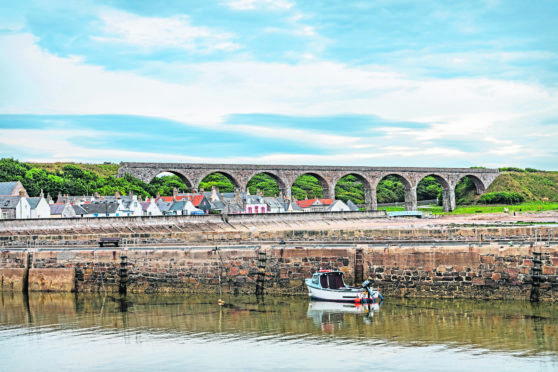
A towering Victorian viaduct frames a picture postcard bay. Through each of its eight spectacular arches, we spy waves, backlit by the low winter sun, crashing on to golden sands. Overhead seagulls dip and dive, cavorting on the thermals.
The view from the A947 coastal road as it sweeps into the historic seaside town of Cullen on the Moray Firth takes our breath away.
But we haven’t had to travel far for the pleasure. Cullen is just over 50 miles from our base near Aberdeen. And although this popular little town is on the North East 250 tourist circuit, we haven’t even had to take the car.
We’ve opted for public transport, making the journey part of the fun. Cullen – home to the world famous fish soup Cullen Skink – is served by Stagecoach bus from Aberdeen’s Union Square.
The route, which takes less than 90 minutes, winds through pretty countryside and along a rugged coastline peppered with tiny villages and bustling towns.
Even in winter Cullen is stunning, a mix of period elegance and quaint stone cottages.
And it lays claim to the North East’s best homemade ice cream parlour amid its cafes and boutique shops that sell everything from antiques to gifts and crafts.
And then there’s the historic Seafield Arms Hotel which takes pride of place on the main street following a stylish £1.3 million revamp.
Built in 1822 by the Earl of Seafield to accommodate visitors to the Seafield Estates, it later became the Seafield Arms and was for generations known as a fine coaching Inn.
Now it is an uber-luxurious four-star establishment with opulent furnishings and luxurious bedrooms, dining and entertaining areas.
And as tempted as we are by its warm, plush interior, we choose instead to take a walk on the wild side. So with jackets zipped to our noses, hats pulled tight to cover our ears and fingers cosy inside fleecy gloves, we head for the Seatown area to wander around a warren of little streets flanked by pretty stone fishermen’s cottages before striking out for the expansive sandy beach to the west.
There are a good selection of other beautiful walks in around Cullen too. A visit to its harbour – designed by Thomas Telford – puts us on track for one of the area’s most spectacular hikes – a 12km (7.5 mile) trek to the village of Sandend via Sunnyside Beach and the ruined Findlater Castle.
The often deserted Sunnyside Beach is a great stopping off point for a picnic and we’re thrilled to spot bottlenose dolphins, and a couple of seals. Orca are also known to frequent these waters.
After a quick coffee from our shared thermos, we leave the beach and climb the path towards the dramatic ruin of the castle that perches precariously over the sea.
It is hard to believe that this inhospitable clifftop fortress was 14th Century home of Sir John Sinclair until tragedy struck. His only son is said to have fallen from the arms of his nurse on to the rocks below, and she, in grief, threw herself into the sea. The family moved inland to nearby Deskford Castle but tragedy struck again in 1411 when Sir John was killed at the Battle of Harlaw, leaving no heir.
Hauling our thoughts back to the present, we continue our walk to Sandend Bay. This enchanting little community dates back to the 1600s and has its own caravan park, camping ground and pretty horseshoe bay.
We see a gaggle of surfers braving the winter waves and discover that Sandend’s Suds Surf School operates year-round.
Back in Cullen its centre for sailing, coastal rowing, kayaking and stand-up paddle boarding, offers courses throughout the year. In summer it’s a mecca for visitors, drawn also to the neighbouring villages of Findocthy, Portknockie and Deskford, and the coastal town of Portsoy – home of the annual Scottish Traditional Boat Festival.
But we have our sights set on Cullen and its namesake dish. Cue the Rockpool Café and Restaurant, a pretty glass-fronted eatery on a corner of the town square.
We have to wait a few minutes to be served because the place is packed – but it’s worth our patience.
Two bowls of steaming, creamy Cullen Skink duly arrive, crammed-full with thick and flaky haddock, chunks of floury potato, onion and parsley.
And just like our stay in this captivating coastal town, it’s heaven on earth.
P.S.
Cullen’s viaducts, one of the great feats of 19th Century railway engineering were built because the Countess of Seafield would not allow the line to cross the grounds of Cullen House.
Factfile
The Seafield Arms Hotel’s bed and dinner promotion from Sun-Thur. Spend £75 on food and pay only £25 for an Urban/Traditional Room or £45 for the MacDonald/Crannoch suites.
Call 01542 841604 or visit seafieldarmscullen.co.uk

Enjoy the convenience of having The Sunday Post delivered as a digital ePaper straight to your smartphone, tablet or computer.
Subscribe for only £5.49 a month and enjoy all the benefits of the printed paper as a digital replica.
Subscribe